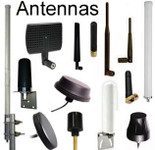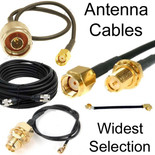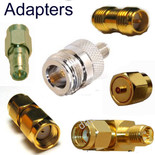Antennas, Antenna Cables, Wireless Products: Technical Articles
Heat Shrink Tubing for Antenna Cables: How-To Apply
Table of Contents
- How-To Guide and Comparison of Adhesive-lined Heat Shrink Tubing to Standard
- 1. Tools: Is a Heat Gun Used in Both Cases?
- 2. How Much Time Does Adhesive Type Add to the Process?
- 3. Challenges of Adhesive-Lined Tubing
- Advantages that Justify the Hassle (Especially Outdoors)
- Summary
- Improved Weatherproofing with Adhesive-Type Heat Shrink Tubing
- How Adhesive-Type Heat Shrink Tubing Works
- Benefits for Outdoor Antenna Cable Installations
- Best Practices
- Summary
- Conclusion
- FAQs
How-To Guide and Comparison of Adhesive-lined Heat Shrink Tubing to Standard
Adhesive-lined heat shrink tubing (also called dual-wall tubing) provides superior protection for antenna cables, but it does come with trade-offs compared to standard (single-wall) heat shrink tubing. Here's a detailed breakdown of the challenges, time impact, and tool usage:
1. Tools: Is a Heat Gun Used in Both Cases?
Yes, a heat gun is used for both types.
Standard heat shrink tubing: Requires heat (~120–180°C) to shrink the polyolefin layer.
Adhesive-lined tubing: Needs the same heat to shrink the outer jacket plus enough heat to melt the inner adhesive layer (typically 90–110°C activation point).
Best practice: Use a high-quality heat gun with a focused nozzle to ensure even heating and controlled melting of the adhesive—avoid open flames (like lighters), which can cause uneven shrinking or burn the tubing.
2. How Much Time Does Adhesive Type Add to the Process?
Extra Time: 30–60 seconds per piece (on average)
Depending on:
Tubing diameter and wall thickness
Ambient temperature and heat gun power
Operator experience
Why?
You must heat more slowly and evenly to:
Ensure full shrinkage
Avoid trapping air bubbles
Allow the adhesive to flow and bond to the cable and connector
Standard tubing shrinks almost instantly once it reaches temp, while adhesive-lined tubing requires holding heat longer until the glue visibly flows and forms a seal.
3. Challenges of Adhesive-Lined Tubing
| Challenge | Details |
|---|---|
| Longer heating time | Requires patience for full adhesive flow |
| Messiness | Melted adhesive can seep out; may stick to gloves, connectors, or tools |
| Higher shrink temp | Slightly more heat needed to activate both layers |
| Less forgiving of mistakes | Misalignment during shrinking is harder to fix once adhesive sets |
| Cost | Typically 2–3x more expensive than standard tubing |
Advantages that Justify the Hassle (Especially Outdoors)
Despite the extra time and care, adhesive-lined tubing is worth it for antenna cable assemblies because it:
Seals out water, dust, and corrosion
Provides strain relief, especially on heavy cables like LMR-400
Bonds to irregular surfaces (knurled SMA/N-type connectors)
This is particularly important in outdoor, marine, or industrial environments.
Summary
Feature | Standard Tubing | Adhesive-Lined Tubing |
Heat gun required? | Yes | Yes |
Time per seal | 10–15 seconds | 30–60 seconds |
Waterproofing | None | Full seal |
Mess potential | Low | Medium (adhesive may seep) |
Ideal for outdoor use? | No | Absolutely |
Cost | Lower | Higher |
Improved Weatherproofing with Adhesive-Type Heat Shrink Tubing
Adhesive-lined heat shrink tubing significantly improves the IP (Ingress Protection) rating and weatherproofing of antenna cables used outdoors by creating a watertight, dust-resistant, and vibration-resistant seal around the cable and its connectors. Here’s how it works and why it’s important:
How Adhesive-Type Heat Shrink Tubing Works
Unlike standard heat shrink tubing, adhesive-lined (dual-wall) tubing has a thermoplastic adhesive layer on the inside. When heat is applied:
The outer layer shrinks tightly around the cable or connector.
The inner adhesive melts, flowing into surface gaps and irregularities.
As it cools, the adhesive solidifies, bonding the tubing to the cable jacket and connector housing.
This creates a mechanically secure and sealed joint.
Benefits for Outdoor Antenna Cable Installations
1. Improved IP Rating
The tight seal created by adhesive-lined tubing helps prevent:
Water ingress
Dust and dirt infiltration
This contributes to achieving IP67 or higher ratings when properly applied—critical for outdoor and marine environments.
2. Weatherproofing and UV Resistance
Protects cable terminations from:
Rain, snow, and humidity
Corrosive environments like coastal air
Temperature fluctuations and UV radiation (especially if tubing is UV-stabilized)
3. Vibration and Mechanical Strain Relief
The bonded tubing reduces stress on:
Coaxial cable shields
Connector solder joints or crimp points
This minimizes signal degradation due to mechanical fatigue or movement, common in rooftop or pole-mounted antenna setups.
4. Corrosion Protection
Prevents moisture intrusion at the connector interface, which can otherwise lead to:
Electrolytic corrosion
Impedance mismatch
Connector failure over time
Best Practices
Use with properly crimped or soldered connectors
Overlap the tubing generously over both the cable jacket and connector body
Apply even heat (preferably with a heat gun) until both shrinkage and adhesive flow are complete
Optionally combine with dielectric grease or silicone sealant for extreme conditions
Summary
| Feature | Benefit |
|---|---|
| Adhesive flow | Creates waterproof and airtight bond |
| Heat shrink grip | Adds strain relief and environmental sealing |
| Dust and moisture resistance | Helps meet IP67/68 ratings |
| UV and chemical resistance | Extends outdoor service life |
Conclusion
Adhesive-lined heat shrink tubing is a simple but highly effective method for sealing and protecting antenna cable connections in harsh outdoor environments — boosting both reliability and service life.
FAQs
What is adhesive-lined heat shrink tubing?
Adhesive-lined (dual-wall) heat shrink tubing has two layers: an outer polyolefin jacket that shrinks with heat, and an inner thermoplastic adhesive layer. When heated, the jacket shrinks while the adhesive melts, bonding to the cable and connector to form a waterproof, dust-resistant seal.
How does adhesive-lined tubing differ from standard heat shrink tubing?
Standard (single-wall) tubing only provides a tight mechanical grip. Adhesive-lined tubing goes further by creating a watertight, dustproof bond that protects against corrosion and mechanical stress—especially valuable for outdoor or marine antenna cable installations.
Do both types of heat shrink tubing require a heat gun?
Yes. A heat gun is used for both. Standard tubing shrinks at ~120–180°C, while adhesive-lined tubing requires enough heat to both shrink the jacket and melt the adhesive (activation point ~90–110°C). Open flames (like lighters) are discouraged, as they cause uneven shrinking and burns.
How much extra time does adhesive-lined tubing take?
On average, adhesive-lined tubing takes 30–60 seconds per seal, compared to 10–15 seconds for standard tubing. The added time is due to the need for slower, even heating so the adhesive flows properly and bonds without trapping air bubbles.
What are the main challenges of using adhesive-lined tubing?
- Longer heating time
- Possible mess from adhesive seepage
- Higher cost (2–3x standard tubing)
- Requires precise alignment (harder to fix mistakes once adhesive sets).
Despite these challenges, its sealing and strain relief benefits outweigh the drawbacks for outdoor use.
Why is adhesive-lined tubing recommended for outdoor antenna cables?
It provides a full waterproof seal, protects against dust, resists UV and temperature fluctuations, and prevents corrosion at the connector interface. It also adds strain relief against vibration and movement—extending cable and connector service life.
What are best practices when applying adhesive-lined heat shrink tubing?
- Pre-fit and align before heating.
- Overlap tubing over both the cable jacket and connector body.
- Apply even heat with a heat gun until adhesive visibly flows.
- Rotate the cable for uniform shrinking.
- For extreme environments, pair with dielectric grease or silicone sealant for extra protection.
Is adhesive-lined tubing worth the higher cost compared to standard tubing?
Yes—especially in outdoor, marine, or industrial environments. While it costs more and takes longer to apply, adhesive-lined tubing ensures long-term reliability by preventing water ingress, dust contamination, and corrosion, making it the superior choice for antenna cable protection.







